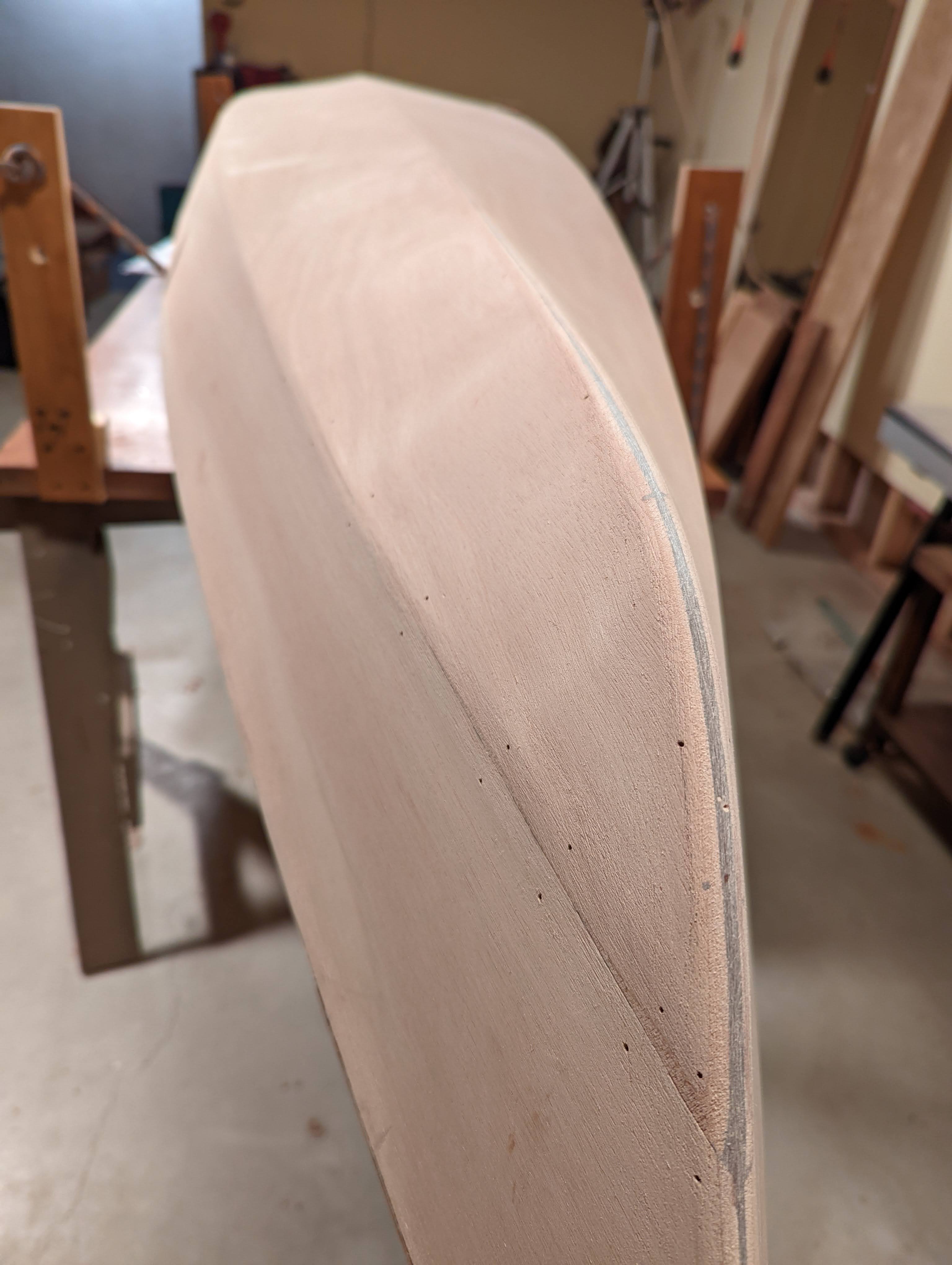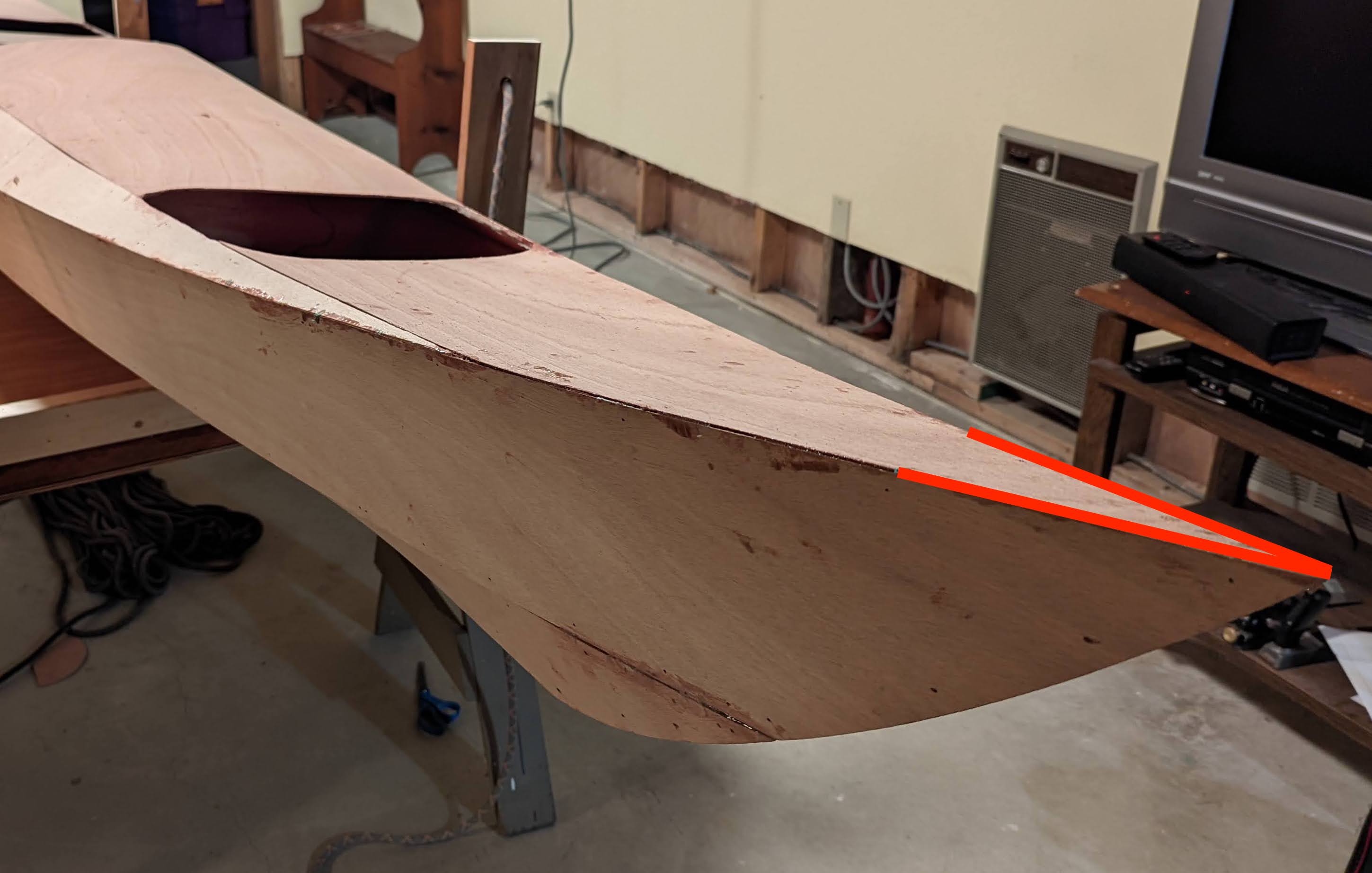Builders' Forum |
|
| ↓ Scroll to Last Comment ↓ | Forum Guidelines | Builders' Forum | |
Minimum edge round overs required to accommodate fiberglass
I'm beginning glassing the hull and deck of a Sectional Shearwater sport. I've had no problem generally knocking down and smoothing various panel joints but there are a few places, specifically on the hull-to-deck line, where I'm not sure what sort of a round over is most appropriate to accommodate the glass.
First, my current reference point on this is the bow and stern. The instructions call for a 1/4" radius here, and it's my understanding that this much round over is required to allow the glass to lay flat over this aggressive edge. I think I've been able to hit that mark (image below), but have needed to plane/sand a decent amount into the fillets to get there. I was comfortable with this since I knew there was decent fillet material available under this joint. Given this is my first build I'm also perfectly content with the little extra dark line here and trust this is a functional edge.

Moving on to the hull-to-deck joint, I know I need to round over this (relatively aggressive) edge a fair amount as well. The glass from the deck will lay over this line and blend down several inches into the hull side panels. The big difference here is that the most aggressive edges of this line (nearest bow and stern -- marked below) are also the locations that have no fillets under them. This is because the hull-to-deck fillets are applied after the deck is fused, and it is impossible to reach these marked locations from the hatch openings. All of this is consistent with the instructions, but it makes me really nervous to now be rounding over these edges for fear of planing/sanding all the way though. I think I can safely get at most an 1/8" radius here, but will that be enough to allow the glass to lay flat and appropriately reinforce this edge? Any other tips on managing the application of glass over these various aggressive panel joints?

7 replies:
RE: Minimum edge round overs required to accommodate fiberglass
Keep in mind that if you get a gap because of the sanding, you can always fill the gap with stiff epoxy/woodflour putty, let it cure and sand it round again. This can be repeated as needed until the gap is sealed, smooth and meets the cloth's minimum bend radius.
Another thing to keep in mind is that the areas you marked are relatively low stress. The deck is mostly flat there and it's solidly attached for the rest of its length with internal fillets and glass. The hull is very solidly joined to itself and does not have the springback that the center section does. In case of a collision, the stiff shape of the bow handles the force of the impact, not the deck. Beacuse of the shape of the sheer the deck really wants to just lay flat there. That portion of the deck doesn't actually need a lot of attachment strength. Because of that, a round-over that exceeds the cloth's minimum bend radius is not the problem that it would be elsewhere on the boat. It will act as a bit of a stress concentrator, but there's not that much stress to concentrate.
You'll be fine,
Laszlo
RE: Minimum edge round overs required to accommodate fiberglass
Your work looks good, and I agree with everything said above, especially using the blue tape to put a little tension on the glass near the tight bend when doing the deck near the bow/stern. Also, if you run a wide strip (2") of blue tape longitudinally on the wood about 2 inches below the deck level down each side of the hull, then wet the glass down to the tape, then let the epoxy set to the plastic stage, and then carefully cut along the edge of the tape with a razor knife just deep enough to peel away the remnant edge of the glass, then peeel the tape (all while the epoxy is still a little soft) you'll end up with a very nicely finished line. Be careful not to do this too early, and/or to pull at 180 degrees (not 90) so you don't lift the glass from the wood when pulling off the remnant edge. Leaves you with no loose threads or whatever to sand out, and a straight line that is almost invisible, but even if slightly visible it is a straight line when finished. You can probably even run a thumbnail or wood tool along the edge of the soft glass after removal of the glass remnant and tape - leaving very little sanding to do to make the line virtually disappear after weave filling, sanding and varnishing.
Don't hesitate to keep the scissors handy and cut some gussetts or divots into the edges of the glass right up to the point where you'll be coating with epoxy. This will help to get things to lay down right near the bow and stern.
And finally, I've discovered with experience that the glass really benefits from lots of "caressing" prior to pouring on the epoxy. Use smooth, clean, dry bare hands and "pet" the glass onto the hull like you'd pet a dog. I think this helps it stretch just a bit on all the biases and even tack itself down by velcro-ing itself to the wood fibers. Much less likely to get wrinkles or bubbles or edges that won't lay down. If your glass has a wrinkle that won't go away before you pour on the epoxy, it usually gets worse, not better, after you do saturate it. And maybe the boat even likes the caresses!
RE: Minimum edge round overs required to accommodate fiberglass
Oh, and if you don't want to see the stitch holes when finished, a little thickened epoxy, or even commercial "Plastic Wood" dabbed into each hole with a fingertip will make them disappear. All it will cost you is maybe an extra 30 minutes to fill them all and then sand them all. If impatient, sanding over them lightly while still a bit tacky might even be preferred, as it seems to blend the sanding dust into the filled hole. About a 50-50 mix of cellofil and wood flour provided with the kit comes out to almost perfectly match the okume color. Of course filling the holes isn't necessary to pass the "10 ft" viewing test, but that's up to you.
RE: Minimum edge round overs required to accommodate fiberglass
Slight correction: You can use the blue tape edge trick whenever necessary (onto wood or glassed mating surface). In this specific case your longitudinal blue tape will be taped onto your recently completed glassed-hull surface, not directly taped to wood. Just trying to prevent any confusion in advance.
RE: Minimum edge round overs required to accommodate fiberglass
Thanks all! This is all very useful information.
Hspira and Bubblehead, thanks for the confirmation that things look good so far. It's hard to get a good sense of progress at times when your only reference point is the instruction book, so I really appreciate forums like this one. The tape trick also sounds interesting. I may give that a test run on some hidden interior surface. Anything that helps avoid wrinkles and all those loose fibers at the edges certainly seems worth exploration. The reminder to consider those stitch holes is also appreciated.
Laszlo, your structural analysis is really interesting and it's good to understand the stress distribution on these designs. I think this information is also useful toward gaining an appreciation for the "why" behind some of the instructions. I was really wondering why the instructions did not address the lack of fillets in these areas, and wasn't sure if there was something special I should be doing to better reinforce them. Your notes give me some good peace of mind!
RE: Minimum edge round overs required to accommodate fiberglass
Depending on how deep you make the end pour, it will also reinforce the connections where you've marked.













RE: Minimum edge round overs required to accommodate fiberglass
» Submitted by hspira - Wed, 2/2/22 » 9:08 PM
Hi rjacobs,
first, very nice work from what i can see in your pictures.
your analysis is pretty much spot on. at the ends, you will probably have less of a radius. so i would follow what you laid out and not try to round it too much.
one of the tips i use for a section like that is to have some tape (simple blue tape works) at the ready to pull the glass down on the tighter edge.
the glassing will be done in two parts - the hull, then the deck. it's the deck glass that you typically pull over/overlap onto the hull. so when you set up to glass the deck, you will work from the center of the boat to the ends. as you get to the end focus on putting the epoxy only on the deck then use some tape to pull the glass down tight along the sides....and then apply your epoxy to the glass on that overlapped area.
see the shearwater below....it's a different shearwater, but a similar problem....so if you enlarge the picture, you can see the radius at the ends is pretty tight....only about the radius equal to the thickness of the wood ~ 4mm = 5/32 inch (= a bit over 1/8 inch).
anyway, you are looking great.
awesome....build on.
h